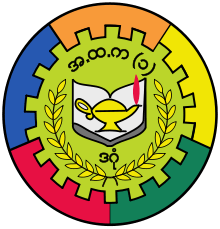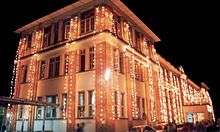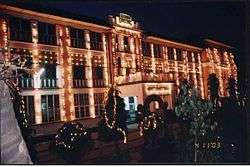Basic Education High School No. 1 Dagon
Basic Education High School No. 1 Dagon (Burmese: အခြေခံ ပညာ အထက်တန်း ကျောင်း အမှတ် (၁) ဒဂုံ; formerly, Methodist English High School; commonly known as Dagon 1 High School), located a few miles north of downtown Yangon is considered one of the best public high schools in Myanmar. Dagon 1 offers classes from kindergarten to tenth standard (recently renamed Grade 1 to Grade 11) to about 6500 students.
| Designations | |
|---|---|
| School အ.ထ.က. (၁) ဒဂုံ | |
|---|---|
 | |
 | |
| Address | |
, | |
| Information | |
| Type | Public |
| Mottoes | Do we learn not for school but for life |
| Established | 1882 |
| School number | 1 |
| Principal | Daw Myint Myint Aye |
| Faculty | 150 |
| Grades | 1 to 11 |
| Number of students | 6500 |
Attended almost exclusively by the children of the wealthy, Dagon 1 has some of the best educational facilities available in a Burmese private school. The school routinely sends a disproportionate share of students to the country's most selective universities each year. Its most famous alumna is the Nobel Peace Prize Laureate Aung San Suu Kyi.[1] Many of the Burmese entertainment industry's top stars are Dagon 1 alumni. Dagon 1 in recent year has lost some of its appeal as a top school as ultra-wealthy parents now send their children to expensive English language medium "international" private schools.[2]
The school's main colonial era building is on the Yangon City Heritage List.[3]
History

The school was founded in 1882 as Methodist Episcopal Girls School on Lewis Street (now Seikkantha Street). In 1894, the school was moved to its current campus on the corner of Lancaster Road (now Nawaday Road) and Signal Pagoda Road, and was also renamed Methodist English Girls High School. The school consisted primarily of a three-story Victorian-era style building 213 feet (65 m) long and 145 feet (44 m) wide. At first, boys were accepted only in the elementary level (from K to 3). During the interwar period, boys were allowed from K to 4. Just before World War II, the school had 55 students. The school was closed down for 6 years after World War II and later reopened in May, 1947. The principal, Mrs. Logie, repaired the school buildings that were destroyed during the war. At that time, the school began to prepare its students not only for the matriculation exam but also for the GCE (General Certificate of Education) exam from the University of London.
In 1951, the number of students increased to 850 and the four-story Kindergarten building (113'×51') with 15 rooms was built in 1952 to accommodate the students. The school's name was Methodist English High School (MEHS). On 14 April 1965, the institution was nationalized and became a public school and has been operated by the government ever since. In 1986, a new three-story building (90'×34') was built to correspond to the increased number of students. The school is currently running under the Department of Basic Education which is directly controlled by the Ministry of Education.
During 1988 democracy uprising, Dagon1 was one of the first high schools in Burma to form student union and participate in the protest boycott marches. Throughout the uprising, members of Dagon1 student union lead their fellow students and teachers in various protest marches. Dagon1 protest column can be clearly distinguished amongst other columns by their Green Flag with White Fighting Peacock emblem, former official flag of All Burma Federation of Student Unions and the green and white represents the uniform colours of high school students. After September 1988 coup by the military, some of dagon1 students went to Thai-Burma border and joined All Burma Student Democratic Front (ABSDF) to achieve democracy and human rights in Burma through armed struggle.
Student body
Dagon 1 has the largest student body in Yangon and in Myanmar, numbering near 6,600.[4] A high student-to-teacher ratio exists, like most of the schools in Myanmar. The students are spread across eleven standards or grades, from Grade 1 (formerly Kindergarten) to Grade 11 (formerly Tenth Standard). Because an increasing demand for enrollment at the school, Dagon 1's student body is in the shape of a pyramid, with the number of younger students outnumbering that of older students. New classes are formed to handle the increased enrollment each year.
Uniform
Like all public schools in Myanmar, Dagon-1 requires that students wear the school uniform at all times. There are two sets of uniform, one for wear from Kindergarten to 5th Standard (Grades 1 to 6), and another, more traditional one for wear from the 6th Standard to 10th Standard (Grades 7 to 11). But all uniforms are of the same colour - a white shirt or blouse, with a green garment for the torso.
School badge
A circular badge, bearing an oil lamp (representing wisdom and education), with a circular cogwheel and a rice plant together with the school's name. Inside the cogwheel, there are 5 coloured sections: Orange, Yellow, Green, Red and Blue representing the school council team colors.
Boys uniform
- From Grade 1 to the Grade 6, male students are required to wear a white shirt (with or without the collar), tucked into a green long pants. Tee shirts and sports shirts are not acceptable. Shoes and the traditional slipper, Hnyat-phanat are permitted as footwear.
- From the Grade 7 onwards, the students have to wear a white shirt (with or without the collar), and a green paso. Only the Hnyat-phanat is permitted. Traditional Mandalay slippers, usually of velvet or other materials, are worn.
Girls uniform
- From Grade 1 to Grade 5, girls can wear either skirts or pants, with a white shirt. Girls usually wear slippers.
- For Grade 6 onwards, the uniform also becomes more traditional like its male counterpart. The girl must wear only the side opening (yin-phone) traditional Burmese blouse, with the Htamein as the lower garment.
Accomplishments
It ranks the highest overall in Burmese High School in the University Entrance Examination, conducted by the Board of Examinations. Dagon-1's student body produces many high scoring students both in terms of collective subjects and individual subjects, making into the very competitive "nationwide outstanding top-ten students' list", colloquially known as the whole-Burma or top ten list quite often.
Although Myanmar's education system is extremely academic oriented, Dagon-1 has been able to produce some good athletes and artists. Dagon 1 has produced many nationally selected athletes, in the fields of swimming, football (soccer), sailing, wushu, and badminton, have won medals in both national and international competitions, such as South East Asian Games.
Many students have also won medals in "Myanmar Traditional and Cultural Performing Arts Competition" (So-Ka-Yay-Tee) and win painting competitions.
In 2011, the top nine scorers of the 2011 Matriculation Exam came from Dagon 1.[5] In 2015, the four of the top 10 scorers in the 2015 Matriculation Exam came from Dagon 1.[6]
Renovations
Due to increasing number of students, a new seven-story building was built in front of the soccer field. To build this building, an old cafeteria building was demolished. With the rising use of the internet and government promotion of information technology, two IT labs have been added to the campus facilities. The Dagon Thiri hall, Chemistry Lab, Physics Lab and Biology Labs are renovated in 2004 for the practical classes. A new cafeteria building was also built and renovated year by year. Security cameras were also installed within the school campus. Some classrooms had been renovated and installed air-conditioners donated by students.
Facilities and buildings
- Three-storey Victorian-era style building (Main Building)
- Five-storey Building
- Three-storey Building
- Seven-storey Building
- Dagon Thiri Hall
- Computer Hall
- Gymnasium
- The Library building at the ground floor of new seven-storey building.
- A Soccer field - Every rainy season, the football matches are held.
- Canteen
- Dagon Thiri Hall - used for religious ceremonies, school reunions and stage shows
- Biology, Physics and Chemistry Labs - On the 5th floor of five-storey building.
- Gymnasium - It also serves as a back-up assembly hall and basketball ground.
- Computer Training Hall - built beside the assembly hall under the government's policy to embrace information technology.
- Multimedia Teaching Lab - Also use as English Language training room.
- IT Lab
- Tennis Court - Inside the garden in front of the school.
List of principals
- Doreen Logie (1947–1965)
- Tun Tin (1965–1966)
- Aung Than (1966–1977)
- Tin Myint (1977–1983)
- Naing Aung (1983–1992)
- Than Swe (1992–1996)
- Kyaw Kyaw (1996–2007)
- Dr. Aung Ko Ko (2007–2012)
- Aung Ko Ko (2012–2015)
- Chit Tun (2016–2018)
- Daw Myint Myint Aye (2018–present)
Notable alumni
Academia
Actors
Actresses
- Wah Wah Win Shwe
- Eindra Kyaw Zin
- Hsu Eaint San
- Poe Ei Ei Khant
- A Nyein Phyu
Businessmen
Directors
- Thura (Zarganar)[7]
- Sin Yaw Mg Mg
Statesmen and politicians
Singers
- Than E (Bilat Pyan Than, Ma Than E Fend, Dora)
- Aung Yin
- Hayma Ne Win
- May Sweet
- Nay Win
- Bobby Soxer
- Nan Su Yati Soe[8]
References
- Whitney Stewart (1997). Aung San Suu Kyi: Fearless Voice of Burma. Twenty-First Century Books. ISBN 978-0-8225-4931-4.
- Sandra Davie (13 October 2008). "I see no future for my two sons in Myanmar". The Straits Times.
- "Special Reports: Heritage List". The Myanmar Times. 29 October 2001. Archived from the original on 15 June 2009.
- ဦးအောင်ကိုကို, ကျောင်းအုပ်ဆရာကြီး. "၂၀၁၄-၂၀၁၅ ပညာသင်နှစ်တွင် သင်ကြားမှုပုံစံများ ပြောင်းလဲသွားမည့်အပေါ် ကျောင်းအုပ်ဆရာကြီး ဦးအောင်ကိုကို(အထက-၁၊ဒဂုံ)နှင့် တွေ့ဆုံမေးမြန်းခြင်း". Popular Myanmar. Archived from the original on 19 August 2014.
- "မြန်မာ တစ်နိုင်ငံလုံး Top စာရင်းဝင် ကျောင်းသား ၊ ကျောင်းသူ ၉ ဦး အ.ထ.က ၁ ဒဂုံ မှ ထွက်ရှိ". MRTV-4. 20 December 2011. Archived from the original on 28 December 2012. Retrieved 4 March 2012.
- "၂၀၁၅ တက္ကသိုလ်ဝင်တန်းစာမေးပွဲ အမှတ်အများဆုံး ၁၁ ဦးစာရင်း (သိပ္ပံဘာသာတွဲ)". 2015. Archived from the original on 22 July 2015. Retrieved 18 July 2015.
- "Zarganar's auto-biography". Archived from the original on 29 December 2007. Retrieved 3 August 2008.
- နန်းဆု, ရတီစိုး (May 25–30). "ကျောင်းဖွင့်ချိန် ရင်ခုန် လှုပ်ရှားမှုနှင့် ကျောင်းသားဘဝ ဖြတ်သန်းခဲ့သူ တို့ စကားသံ". Popular Myanmar. Archived from the original on 2014-08-09. Check date values in:
|date=(help)